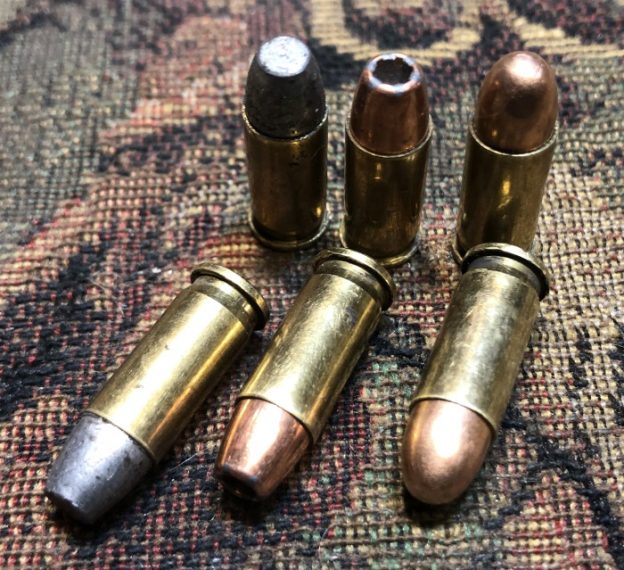In our last episode we discussed the Mauser 6.35mm and the effect of it’s three inch barrel on performance, which prompted a reader to ask about the performance of factory ammunition in a two-inch barrel .25 auto. As it happens Linda has a Colt Junior with a 2″ barrel, and I happened to have some factory… Oh. No, I don’t. But I did have some just-arrived 50gr FMC-RN bullets from PPU, so I consulted the reloading data and came up with a load I thought would approximate factory ammo.
As it happened I also had some Speer 35Gr Gold Dot hollow-points, so I thought I might try those as well.
Put Not Your Faith In Reloading Manuals!
Lee Precision’s reloading data suggested a 50gr. FMC-RN Loaded over 1.1gr of Red Dot would yield a velocity of 740 fps. and 61 ft./lbs. of energy. This nearly duplicates the performance of American Eagle 50gr. TMJ ammunition fired from a 2″ barrel, so that ought to do for the ‘factory ammo’ equivalent. Or so you would expect…
I set up the Caldwell chronograph and had a go. It seems Lee was a tad optimistic. From the Colt Jr.’s 2-inch barrel this gave 619 fps. and 43 ft./lbs. That’s, uh, interesting. Just for giggles I tried it from the Mauser’s 3″ barrel. Huh. 712 fps. and 56 ft.lbs. Gotta wonder what sort of gun Lee was testing this load out of…
So what was performance like in Clear Ballistics 10% ordinance gel? From the 2″ gun it was uninspiring.
9″ of penetration. The bullet did tumble and maintained a relatively straight wound track, so that’s in it’s favor. The load fared somewhat better out of the Mauser, and is reasonably close to the performance listed in the manual so it gives us a better idea how factory ammo might behave in a 2-inch gun.
A bit over 13″ of penetration in the gel, with a slightly curved wound track. The bullet did not tumble. I think this gives a decent idea of how factory ammo would perform from a 2″ gun.
It has been noted that the FMC-RN bullet is an uneven performer in this caliber, with the round nose sometimes causing the bullet to be diverted by bones such as the ribs or skull if it does not strike squarely.
Let’s Rev It Up Some
So, about those Gold Dots… Looking over the available data I found a load tested in a 2″ Beretta, and thought that would be a good place to start. This had the 35gr GDHP loaded over 1.7gr. of Red Dot with a CCI500 small pistol primer, yielding a velocity of 946 fps. and 70 ft./lbs. of energy.
From the Colt Junior this actually gave 994 fps. and 77 ft./lbs. The bullet even mushroomed a bit.
But there’s trouble in paradise; with low-energy bullets generally you can have expansion or penetration, pick one. This load was no exception.
The bullet penetrated about 8″ of gel, which is generally considered far too little for reliably damaging critical structures in the human body. This does closely approximate the results of tests I’ve seen of factory Gold Dot ammo, so no real surprises here.
The Mauser’s extra inch imparted a significant improvement in velocity and energy. 1067 fps. and 89 ft./lbs., and three recovered bullets showed excellent, uniform expansion.
That’s the good news. The bad news is that while penetration was better it still wasn’t good. The most expanded bullet stopped at around 7-3/8″. The other two made about 8-1/2″ and 9″. Given that 12″ is the FBI’s specified minimum penetration this must be considered, inadequate, or marginal at best.
I think I should test this load against FBI-standard and fire it through four layers of denim; I think it would actually perform better if the hollow-point was plugged and expansion was limited or prevented.
The Take-Away
Energy doesn’t tell the whole tale. The most powerful of these loads also offered the worst performance as it’s expansion limited penetration.
.25 ACP was one an extremely popular caliber for small pocked pistols, but since the GCA1968 made it problematic to import the tiny pistols that chamber it the caliber’s popularity has waned and it’s market-share has diminished. Today very few companies offer guns in this caliber. This means that ammunition companies have little incentive to improve on it, and by-and-large haven’t.
The venerable .25 is considered inadequate for self defense these days, and not without reason. It could be useful for jobs like pest control or small game, but at it’s best it duplicates the performance of .22 LR, which is offered in guns more suited to such roles, is notably less expensive to shoot and (in normal times) more readily obtainable.
Of the rounds I’ve tested my handload using the Rimrock 55gr (actually 58gr. in the box I purchased) shows the most promise; it tracks straight in gel and penetrates consistently to about 12.5″ when fired through four layers of denim from a 2″ barrel. I also feel the hard-cast flat-point is less likely to be defected by bones in self-defense scenario.
I think a FMC flat-point, or even a a slightly concave point (to provide an edge to catch on bone and prevent deflection) weighing 55-60gr. might be the best one could reasonably do in this cartridge, but again there is little incentive to go to the difficulty and expense of developing new bullets.
A few folks have suggested that perhaps I should look into the idea of a .25 Super Auto, perhaps driving that 58gr. LFP bullet at 1150 fps. but that would require building an entire new gun to fire it, which might be a bit much. Hmmm…
Stay safe and take care.
Michael Tinker Pearce, 8 May 2021
If you like what you read here, please consider clicking the link above and supporting me on Patreon.
